Portland’s friendly annual competition among workplaces to see who can log the most and longest bike trips and who can recruit the most commuters starts today. And an excellent new academic paper shows exactly why you should be signing up and nudging your co-workers to do the same.
The paper published last week is by New York-based biking psychology student Do Lee, based on interviews, mapping and video and ride-along observations of the two-week Lake Tahoe Bike Challenge in California.
His simple conclusion: no amount of infrastructure or logic is ever going to give people the confidence and information they need to make a rational decision about whether they should commute by bike.
For confidence, they have to see other people doing it — and for information, they simply have to try it.
Lee’s study, which won a “best student paper” award last year from his regional division of the American Psychological Association, is unfortunately behind a paywall. But we can share some key insights here that ring true.
Most people have no idea where bike infrastructure is located
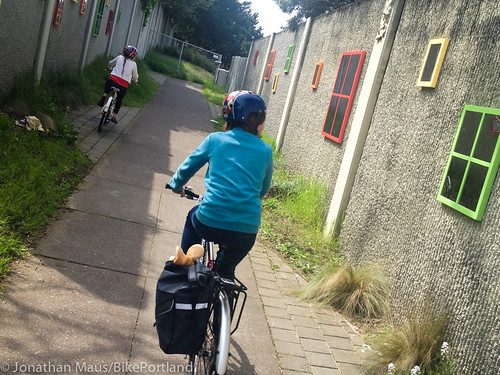
When I was considering a bike commute in 2009, I emailed a friend to ask how long he thought it would take to bike from the Arbor Lodge neighborhood in north Portland to my job in downtown Vancouver.
“I’m going to say it would take you about 15 minutes,” he replied. “Provided that the car you get rear-ended by on I-5 deposits your remains at your desired location.”
My friend (a Portlander if there ever was one) had driven to Vancouver before but had no idea that there is a bikeable path across the Interstate Bridge. And in that, Lee finds, he was like most people who have only taken a particular trip in a car.
“Many bicyclists prefer designated bike paths and informal bike trails but these routes are usually located away from the main roads and are often difficult to spot while driving,” Lee writes. “Prior to their first bike to work event, many participants lacked knowledge of bike routes other than those immediately visible while driving.”
For Portland’s bike network, which is dependent on our generally pleasant but hard-to-spot neighborhood greenways, this hurdle is especially high. But the practical experience of piecing together a bike commute for the sake of workplace camaraderie can break it down, Lee writes.
People driving see only the worst parts of bike commuting
Most people who commute by car come across people biking from time to time. Where are they most likely to do so? During the very worst moments of a bike commute — the moments when the bike commuter has to interact with cars.
Is it any wonder that so many car-centric people see bikers, and biking, at their worst?
In his interviews, Lee found that people thought biking is always like that.
“In essence, the participants forecast an experience of bicycle commuting that is filtered through their experiences of driving,” he writes. “The driving environment renders the positive aspects of bicycle commuting invisible while drivers simultaneously project negative qualities onto any bicycle commuting that remains visible.”
Only by escaping the car for a day or two can someone understand that a lot of bike commuting is actually less stressful than driving.
Advertisement
Rich and poor people alike are motivated by more than just money
There’s a popular myth that some people who don’t own cars bike because they “have to.” But people of every income level are making choices all the time. Someone who doesn’t own a car might carpool, ride a bus or simply make painful financial sacrifices to buy a car.
Lee’s research suggests that you don’t have to be an office worker to respond to a bike-to-work challenge.
“The two Latino males in this study were both blue-collar laborers who worked multiple jobs; yet, both spoke of becoming bicycle commuters not out of economic necessity, but based on complex experiences and motivations facilitated by the event,” he writes. “Based on their interviews, both participants would not have known about and experienced the event without having a workplace team.”
On the downside, Lee found, bike-to-work events often end up targeting office workers, neglecting people who work other jobs and ignoring people who focus on unpaid work like parenting.
“The event did not exclude anybody from participating, but the event’s outreach favored the social environments of middle class, well educated, and mostly white social networks in Tahoe despite a sizeable local Latino bicycling population,” Lee writes.
Moral of the story: Bike lanes aren’t nearly enough
Bike infrastructure is great for those of us who already ride. But it does little to boost the number of people biking unless people get on their bikes for the first time — and getting people on bikes requires social support.
“Bicycling infrastructure alone is not enough to encourage cycling, because the material and social conditions of a car world render bicycle commuting as largely invisible and unviable for everyday transport,” Lee writes. “Lived experience is the essential bridge to knowing how one’s environment affords bicycle commuting in daily life.”
As we’ve reported, the Bicycle Transportation Alliance’s free-to-play competition has been steadily shrinking since 2011. But the BCC’s major funders at Metro doubled down in 2015 by boosting their support for the program.
Let’s hope it works. There’s little question that the BCC has played a big role in helping thousands of Portlanders discover the joy of bike commuting.
“Real freedom is about breaking from automatic and unconscious habits and routines in order to search for new possibilities of being in the world,” Lee writes, quoting the late philosopher Maxine Greene.
Here’s to that.
Thanks to Jessica Roberts, a bike programming expert at Alta Planning and Design, for the tip about Lee’s work.



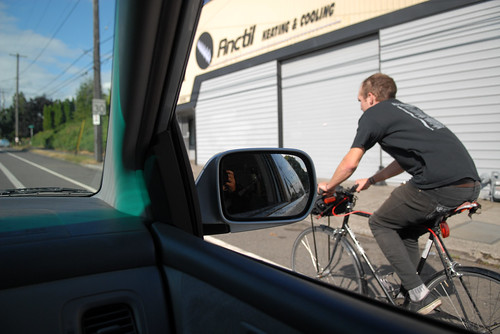
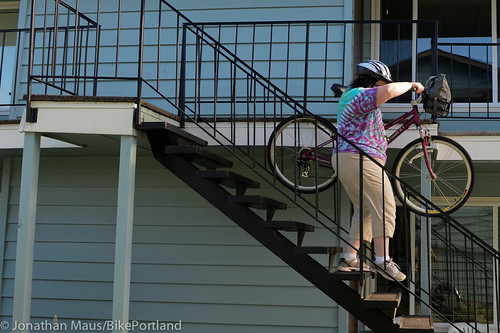
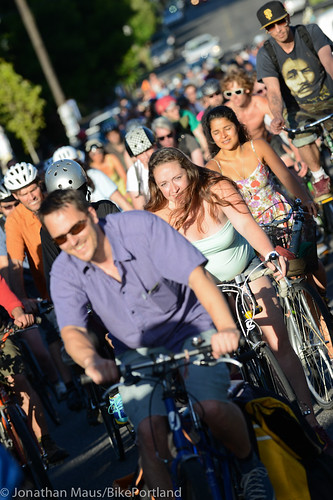


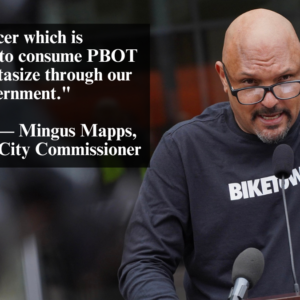

Thanks for reading.
BikePortland has served this community with independent community journalism since 2005. We rely on subscriptions from readers like you to survive. Your financial support is vital in keeping this valuable resource alive and well.
Please subscribe today to strengthen and expand our work.
I think it takes an approach from multiple sides. Yes, people are more likely to ride if they have the social support. But discounting the importance of safe and obvious cycling infrastructure would be a mistake. If our best bike paths are “out of sight”, that’s just a failure of planning.
Good cycling infra should be obvious and visible. People who drive that start riding their bikes frequently ride down the arterials because they are used to driving down those roads and don’t know about the greenways. The solution should be to build protected bike lanes on the arterials, to make them more visible. Look at the Esplanade: it’s visible and obvious and gets a lot of usage.
I see the mayor signed up:
http://bikecommutechallenge.com/profile/59572/
Who is going to challenge him? 🙂
I challenged the mayor. I’ll let you know if he accepts my challenge.
Do we need a kickstarter to get him some fenders?
Looks like he’s signed-up the whole council. Looking forward to seeing 4-5 trips per day on there.
Amen brother! Off street bike facilities are so unknown to most area commuters…even with the blessed apps of Google and Zaia’s Bike Map / Maplets that tell you where you are. I am always surprised (startled) at the number of Portlanders I see getting lost on the I-5 Interstate path and starting to ride on the highway portion to Vancouver.
This was my motivation for developing the “RU Bridge Curious” guided rides 10 years ago and for adding the Portland bike map to the backside of the CoVs first modern bike map in 2008. (Sadly the next edition is replacing Portland with Clark County…returning back to the 90s.)
RU Bridge Curious poster by local artist Shawn Granton
http://www.sito.org/cgi-bin/egads/showart?show=sgr.0070
Past Tours (needs a new host to guide the rides)
https://btaoregon.org/2008/09/special-i-5-bridge-bike-path-tour/
nothing on their website about a one on one bike buddy program. Is there nothing for the potential solo commuter who would like help getting started ?
BCC is awesome, but for the life of me I can’t figure out why it’s in the fall.
Move it to May!
If it were in the spring, people might do the challenge, realize how great it is, keep it up while the weather is great, and potentially stick around through the rain. Even if they stop when it starts raining, we’d have eliminated a few months worth of pollution and congestion.
As it stands, people start when the weather is nice, are at it for a few weeks, and give up as soon as it starts raining, *maybe* making it all the way through the month.
Historically, it was because the BTA had two major events – the Bike Commute Challenge and the Alice B. Toeclips fundraising event. Alice was in the spring, and it made no sense staffing-wise to do the BCC at the same time, as these were pretty staff-intensive efforts. The other fundraising events we were “competing” with tended to be in the fall.
There was also some who argued May is not dependably good biking weather, but September tends to be, and that the BCC sets stronger habits by not being during the summer while school is out and people are taking vacations (that is, doing something four weeks in a row really burns the habit into people’s brains).
There were some who believed we were connecting to commuters (and new commuters) at just the time that it was transitioning to be harder for some people — that is, a few drizzles. We could email them, and also help their coworkers provide them advice and social support about how to ride in the rain.
But yes, we were aware we were counter-programming with the rest of the country (and the national bike commute challenge).
I have done the commute challenge in May up in Seattle for the past three years and I’m super disappointed that there won’t be challenge this spring for me to participate in now that I live in Portland.
Yep, in those few places where cycling numbers have been significant (PDX isn’t one of those) social infrastructure is clearly a huge factor. However, social infrastructure includes such things as the range of acceptable motorist behavior and the level of law enforcement.
Ask someone in Amsterdam for a “bike map”.
ohsu has ~10,000 people signed up for their bike commute program but the bta has, thus far, refused to count these commutes without a laborious sign up for each commuter. this is sad because they miss people like me who have not commuted by motorized vehicle of any kind for over a decade.
Whats so hard about the sign up?
You just need to register once and join your team. Then you literally click two buttons on your computer: the bookmark for the “trip log” webpage, and the day of the week. It is that easy.
We need something comparable to Sunday Parkways but for shopping. Streets like Division, Hawthorne, Belmont, Glisan, Sandy, Alberta, Killingsworth, N Lombard in St Johns, NW 23rd, etc would be a great places to direct some merchant love.